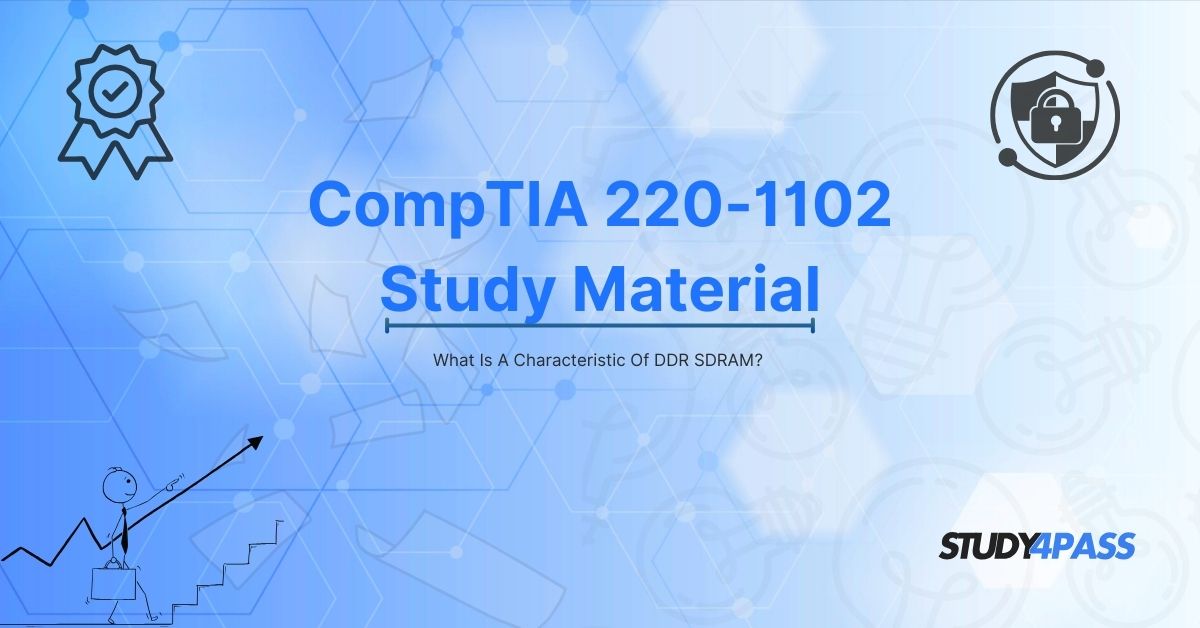Introduction to DDR SDRAM
In the world of computer hardware, memory plays a crucial role in system performance. One of the most widely used types of memory is DDR SDRAM (Double Data Rate Synchronous Dynamic Random-Access Memory). Understanding its characteristics is essential for IT professionals, especially those preparing for exams like IT Essentials 8.0 and CompTIA A+ (220-1102).
This article will explore the key characteristics of DDR SDRAM, its evolution, and its importance in modern computing. Additionally, we will discuss how Study4Pass provides high-quality study materials to help students and professionals master these concepts for certification exams.
What is DDR SDRAM?
DDR SDRAM is an advanced type of SDRAM that allows data to be transferred on both the rising and falling edges of the clock signal, effectively doubling the data rate compared to traditional SDRAM. This technology has evolved through several generations, including:
- DDR (First Generation)
- DDR2
- DDR3
- DDR4
- DDR5 (Latest)
Each generation offers improvements in speed, power efficiency, and bandwidth.
Key Characteristics of DDR SDRAM
1. Double Data Rate Technology
- Unlike standard SDRAM, which transfers data only once per clock cycle, DDR SDRAM transfers data twice per cycle (on both the rising and falling edges).
- This effectively doubles the bandwidth without increasing the clock frequency.
2. Synchronous Operation
- DDR SDRAM operates in sync with the system bus clock, ensuring efficient communication between the RAM and CPU.
- This synchronization reduces delays and improves performance.
3. Higher Bandwidth
- Each DDR generation increases bandwidth:
- DDR: 2.1–3.2 GB/s
- DDR2: 4.2–6.4 GB/s
- DDR3: 8.5–14.9 GB/s
- DDR4: 17–25.6 GB/s
- DDR5: 32–51.2 GB/s (and beyond)
4. Lower Voltage Requirements
- As DDR technology advanced, voltage requirements decreased, improving energy efficiency:
- DDR: 2.5V
- DDR2: 1.8V
- DDR3: 1.5V
- DDR4: 1.2V
- DDR5: 1.1V
5. Increased Prefetch Buffer
- DDR SDRAM uses a prefetch buffer to enhance performance:
- DDR: 2-bit prefetch
- DDR2: 4-bit prefetch
- DDR3: 8-bit prefetch
- DDR4 & DDR5: Further optimizations
6. Not Backward Compatible
- Each DDR generation has a different pin configuration, meaning:
- DDR3 RAM cannot fit into a DDR4 slot and vice versa.
- Motherboards must support the specific DDR type.
7. On-Die Termination (ODT)
- Reduces signal reflections and improves data integrity at higher speeds.
- More prominent in DDR4 and DDR5.
8. Error Correction (ECC Support in Some Variants)
- Some DDR modules support ECC (Error-Correcting Code) for improved reliability in servers and workstations.
DDR SDRAM in IT Certification Exams (IT Essentials 8.0 & 220-1102)
Understanding DDR SDRAM is crucial for exams like:
- IT Essentials 8.0 (Covers hardware fundamentals)
- CompTIA A+ 220-1102 (Includes memory types and performance factors)
Why Study DDR SDRAM for Exams?
- Hardware Identification: Questions may ask about DDR pin counts, speeds, or compatibility.
- Troubleshooting: Knowing DDR characteristics helps diagnose memory-related issues.
- Performance Optimization: Selecting the right RAM improves system efficiency.
How Study4Pass Helps You Master DDR SDRAM & IT Certifications?
When preparing for IT Essentials 8.0 or CompTIA A+ (220-1102), having the right study materials is essential. Study4Pass offers:
1. Comprehensive Study Guides
- Detailed explanations of DDR SDRAM characteristics, comparisons between generations, and real-world applications.
2. Practice Questions & Mock Exams
- Test your knowledge with DDR-related questions similar to those in CompTIA certification exams.
3. Up-to-Date Content
- Study4Pass ensures all material aligns with the latest exam objectives, including DDR4 and DDR5 advancements.
4. Expert Explanations
- Complex topics like memory timings, bandwidth calculations, and compatibility issues are broken down into easy-to-understand lessons.
5. Interactive Learning Tools
- Flashcards, quizzes, and video tutorials help reinforce memory concepts effectively.
By using Study4Pass, students gain a competitive edge in mastering IT certification topics, including DDR SDRAM.
Final Thoughts
DDR SDRAM is a fundamental component of modern computing, with distinct characteristics such as double data rate, synchronous operation, and generational improvements in speed and efficiency. For IT professionals and certification candidates, understanding these features is crucial.
For those preparing for IT Essentials 8.0 or CompTIA A+ (220-1102), Study4Pass provides the best study materials, ensuring a deep understanding of DDR SDRAM and other essential topics. With structured guides, practice tests, and expert support, Study4Pass is the ideal platform for certification success.
Start your journey today with Study4Pass and ace your IT exams with confidence!
Special Discount: Offer Valid For Limited Time “CompTIA 220-1102 Prep Materials”
Sample Questions for CompTIA 220-1102 Exam Prep Practice Tests
Actual exam question from CompTIA's 220-1102 Study Guide.
1. What does DDR in DDR SDRAM stand for?
A) Double Data Rate
B) Dual Data Rate
C) Dynamic Data Rate
D) Direct Data Rate
2. How does DDR SDRAM differ from SDR SDRAM?
A) DDR uses lower voltage
B) DDR transfers data on both rising and falling clock edges
C) DDR has higher latency
D) DDR does not require a clock signal
3. Which of the following is a key feature of DDR SDRAM?
A) It operates at half the speed of SDR SDRAM
B) It uses a single clock edge for data transfer
C) It doubles the data rate without increasing clock frequency
D) It does not require a memory controller
4. What is the typical voltage requirement for DDR SDRAM?
A) 1.8V
B) 2.5V
C) 3.3V
D) 5V
5. Which generation of DDR SDRAM introduced a prefetch buffer of 2 bits?
A) DDR1
B) DDR2
C) DDR3
D) DDR4


